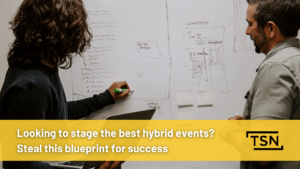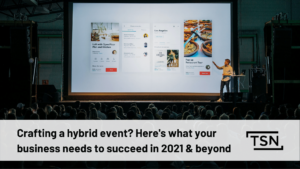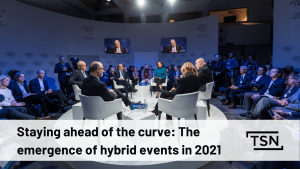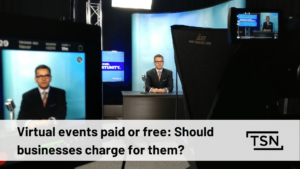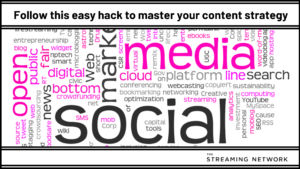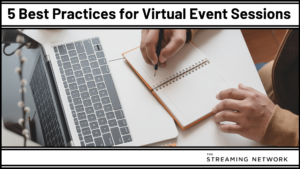Podcast: Play in new window | Download | Embed
Subscribe: Apple Podcasts | Google Podcasts | RSS
It’s one thing to make a webinar, but another thing entirely to create one that truly drives your audience to action.
In the third installment of Lessons from the Frontline, we discuss specific steps marketers can take to turn viewers into participants.
In Our Third Episode We Discuss:
- Audience Engagement: You can’t expect more than 10% of your audience to ask questions if you don’t allow people to speak.
- Visual Information Retention: If your audience isn’t listening to the podcast then it’s watching the video version. 90% of the information transmitted to our brains is visual.
- The Element Of Pacing: Varying the pace of your webinar—starting light and ending on a more serious, CTA-driven note—is essential for engagement success.
- The Art Of Questioning: Posing a question early on as a poll or a specific slide, letting it linger, then slowly answering it as the webinar goes on helps drive curiosity and engagement.
The Complete Video Transcript
Mr. Peter: Matt Ley, welcome back to the webinar, Lessons from the Front Line. Today’s episode is tips and tricks, how to drive webinar engagement.
I was reading a couple of articles in which you were quoted about creating content that engages. You’re a big advocate of engagement metrics. It ultimately boils down to entertaining audiences, right? That’s sort of the fundamental thing.
So, how do we make webinars more entertaining?
Mr. Matt Ley: Well, I mean, I think the simple thing that we do is we move away from what has become the webinar format, because it paramounts to a lecture followed by a Q&A, right?
And y’all remember what it was like when you were in university or college or wherever it was. You got lectured and by the end, when they asked does anyone have any questions, you’re pretty much looking to bolt for the door. And that’s because you had another class to get to, that’s because you maybe weren’t all that interested in the topic to begin with. You had to be there, right?
Mr. Peter: Yeah.
Mr. Matt Ley: And so, when we lecture our audience in this day and age–and remembering that they’re not in a conference hall, they’re at their laptop–is they’ve got that next meeting they need to get to. Maybe get that coffee, maybe handle that email–.
Mr. Peter: –Yeah–.
Mr. Matt Ley: –That they didn’t because they were on the webinar–.
Mr. Peter: –They’ve booked an hour–.
Mr. Matt Ley: –They booked an hour–.
Mr. Peter: –An hour is–.
Mr. Matt Ley: –But if they can get 10 minutes back, they well, right?
Mr. Peter: Yeah.
Mr. Matt Ley: And so, the format–no one likes to be lectured, you know. As good as it is, lectures are not that entertaining.
Mr. Peter: Yeah.
Mr. Matt Ley: So, it’s not something that promotes engagement, if you will. And a webinar should not be a medicine that we have to take, right?
Mr. Peter: Yeah.
Mr. Matt Ley: It should be something that if we’re going to give of our time, we want to be informed. To your point, entertained, but most importantly, get out of it what we hoped to get out of it.
Mr. Peter: Right.
Mr. Matt Ley: So, I look at engagement and entertainment as two different things. I think they go hand-in-hand. I think it’s important and the more entertaining or the more enjoyable the presentation style and format is, the more engagement you will get from your audience. But I think engagement, what we really need to really drill it down to, is getting that audience to take action. That’s what engagement is on the interweb–.
Mr. Peter: –Right–.
Mr. Matt Ley: –And that’s what we want to be promoting in our webinars.
Mr. Peter: Right. So–and I like your t-shirt, by the way–.
Mr. Matt Ley: –Thank you–.
Mr. Peter: –Hillary 2016–.
Mr. Matt Ley: –Busted it out for some reason, right?
Mr. Peter: Yeah. We are a nonpolitical podcast here, so I’ll be wearing my “Make America Great Again” baseball cap for the next podcast.
Mr. Matt Ley: Fair enough.
Mr. Peter: So, in terms of engagement then, let’s focus on that first. What defines engagement in your world? Because engagement–.
Mr. Matt Ley: –Yeah–.
Mr. Peter: –Can mean any number of different things.
Mr. Matt Ley: Yeah.
Mr. Peter: This microphone is engaged in a–on a stand.
Mr. Matt Ley: Yeah. So, in my world, the way that I feel that engagement is, is that they are taking action a number of times throughout the webinar can show engagement. So, we measure it based around time in webinar and what they’ve done while they’re there.
So, whether it’s our platform or anyone’s platform, it’s: Did they ask questions? That shows a level of engagement. If you presented to them options in the form of a poll or a survey or a form, field somewhere in the webinar, did they take the time to kind of fill that out or to respond to you? And, if you’ve offered any other CTAs or any other options for them, whether it be to connect with the speaker on LinkedIn, to, you know, visit a promotional webpage that you set up on the topic, download an e-book or a resource, each of those things show a level of engagement.
Mr. Peter: Right.
Mr. Matt Ley: So, it’s not just doing one thing. It’s doing things throughout the webinar that show that they’re there and they’re with you. It’s like–this is the only way in a webinar to make it akin to when you’re at a conference and you ask people to raise their hands or you ask people to shout out answers, and you do such a good job that the entire audience is shouting stuff out. That’s an engaged audience.
Mr. Peter: Yeah.
Mr. Matt Ley: The only way you know if your audience is engaged–because, you know, they can shout at their laptops, you’re never going to hear them in a webinar–.
Mr. Peter: –Yeah–.
Mr. Matt Ley: –Is if they’re clicking and they’re taking action throughout.
Mr. Peter: And you can track all that sort of thing if you’ve got the right platform?
Mr. Matt Lay: Generally speaking, yeah, you can track all of that.
Mr. Peter: Right. So, give us some tips then, tricks and tips. If you’ve got an hour, you want to get them engaged–.
Mr. Matt Ley: –Yeah–.
Mr. Peter: –You want to be able to measure that, what are, like, some neat little things you can do as a producer?
Mr. Matt Ley: Well, the first thing you need to do is you need to give them room, and what I mean by that is you need to give them room to engage. You can’t hope that more than, say, 10% of your audience asks a question if you don’t have any room for questions to occur.
Mr. Peter: Right.
Mr. Matt Ley: And so, a big faux pas that people have, regardless of all of the tricks we’re going to get to later in this podcast, is that they’ll try and jam just way too much content in, or they will prioritize the content that they planned over the questions and the feedback that they’re getting from their audience. So, they’ll have 45 slides or something silly like that and they’re going to need to get through all of that before the end of the webinar, regardless of the types of questions that are coming in.
And so, what we generally recommend that people do in a one-hour, let’s say, allotted time frame is they plan for just over 30 minutes of content and hope that the engagement drives the rest of the dialogue.
Mr. Peter: Right.
Mr. Matt Ley: There’s other things you can do if you don’t get that engagement, but still don’t plan for an hour of content.
Mr. Peter: Right.
Mr. Matt Ley: And then, I mean, if I was going to talk about it, the first trick that I would say after you’ve done that is you’ve got to create trust with your audience. And by that I mean, there’s a distrust in the Internet because webinar providers like ourselves are doing things like simulating the live experience where no questions are getting answered.
There are–is distrust that people will not answer challenging questions. There’s distrust that maybe all of the questions are planted, as that was a trick that we put forward, you know, 10 years ago when–maybe even before that when Hillary’s husband was in office
Mr. Peter: Right.
Mr. Matt Ley: And so, there’s–so you gotta create trust so that they know that if they do submit their questions or they do give you feedback that you are going to reference it.
So, one thing that we suggest is that regardless of what it is, early on in the webinar, within I would say between kind of your introduction and probably after this question in a webinar setting, we would take something from the audience.
Mr. Peter: Right.
Mr. Matt Ley: Whether it’s a comment about my Hillary shirt or it’s a comment about the sign you selected for today. Maybe, it’s a question that we’re going to get to anyways, but who cares? Let’s just answer it.
Mr. Peter: Right.
Mr. Matt Ley: Now they’ve–that persons got a lot of trust with you, but your entire audience now is like, hey, they’re actually going to get back to us on this stuff–.
Mr. Peter: –Yeah–.
Mr. Matt Ley: –So we should submit–.
Mr. Peter: –They are starting to think now–.
Mr. Matt Ley: –Yeah, they’ll start to submitting more questions.
Mr. Peter: Coming up with questions–.
Mr. Matt Ley: –Yeah–.
Mr. Peter: –And it also helps, I guess, break up the pacing. It does all kinds of–.
Mr. Matt Ley: –Yeah–.
Mr. Peter: –It does all kinds of things. So, that’s great. So, what if they still don’t engage? What if you try that you don’t–even like in the middle you don’t–nothing comes back? You’ve tried all your tricks. What then?
Mr. Matt Ley: Well–.
Mr. Peter: –What’s the last gasp?
Mr. Matt Ley: Well, I–there’s a lot of stuff that you can do, right? I mean, but I think that what–what we usually say to people when we–when they talk about engagement with us–we have a survey that we do, it’s called the webinar report card, and we use the first question to find out what people are talking about. Like, what’s the number one problem you think you have in your webinar program.
And consistently people said they want their webinars to be more engaging. So, it’s up there, right? So, we have to create an answer for that we can synthesize, and our synthesized answer for that or our slogan for it, is that format plus choice equals engagement.
Mr. Peter: Right.
Mr. Matt Ley: And what we mean by that is you want to have a format, like I said earlier, a format that provides room for engagement. There are certain types of formats, like Q&A, that make people feel like they’re part of the dialogue. That creates engagement or can drive engagement.
But you want to give them choice. The fact that less than 10% of audience members on webinars will submit questions is partly because of how boring webinars have been for so long and how we lecture people and then ask them for questions at the end. But, it’s also because people, in this day and age, feel like they should be able to find their own answers, right? They’re more prone in the business world to ask Google whether or not they should buy from you, than to call you and ask you.
Mr. Peter: Right.
Mr. Matt Ley: They’re self-educated.
Mr. Peter: Right.
Mr. Matt Ley: So, we got to give them choice for how they engage with us. And if you’re only going to offer them one thing–like the worst is that some people will do like an open chat. The only way someone can engage with you throughout the entire webinar is to participate in an open conversation where their question is seen by other audience members and is out there in the open.
Mr. Peter: Right.
Mr. Matt Ley: There’s a number of people who just will never do that, right? To do that. So, you want to give them choice.
Let them ask them ask a question. Let them engage maybe on social media with people. Potentially let them do some of their own research within the console, like–or webinar experience, we call it a console–like downloading more facts or more information on the case study or linking to websites that support what it is that you are talking to.
Put out polls that are not part of the dialogue or the conversation, where you’re asking them questions while you’re going through–we call it nonlinear polling. While we’re talking, we could be asking the audience certain questions–.
Mr. Peter: –That they could then be–.
Mr. Matt Ley: –And they could be responding while they’re listening–.
Mr. Peter: –Right.
Mr. Matt Ley: Because if not, you know what you’re going to do.
Mr. Peter: Yeah.
Mr. Matt Ley: You’re going to go to the interwebs. You’re going to check Facebook. You’re going to check your email while this is going on. And we want to keep them in there, so we need to give them choice–.
Mr. Peter: –Yeah–.
Mr. Matt Ley: –People expect choice.
Think about how you get your news now. Your feed is customized to you base around your preferences and if Google or Yahoo or whoever you use fouls that up, you get a chance at changing it so you’re getting the type of news that you want. The type of media you want, the face–.
People are the same way when they’re engaging in a webinar. They want to be able to get the information that they want when they want it.
Mr. Peter: Right.
Mr. Matt Ley: So, format and choice should, you know, get people engaging on a psychological level as well as that need to click level.
Mr. Peter: Right, right. So, now I’ve never seen or I can’t recall seeing a webinar where PowerPoint didn’t play sort of an essential part.
Mr. Matt Ley: Yeah.
Mr. Peter: Should webinars in this–you know, if you’re trying to entertain people–I’ve sat in meetings–.
Mr. Matt Ley: –Yeah–.
Mr. Peter: –And nothing could get more boring than a poorly-presented PowerPoint. But, is that a thing? Is PowerPoint an essential part of the webinar experience?
Mr. Matt Ley: A presentation is. PowerPoint happens to be the ubiquitous, Microsoft-based solution that every platform supports from an upload perspective and so it is generally the base of where a webinar starts. But PowerPoint into itself, what is it? It’s pictures and it’s images. Sometimes it has video. Sometimes it has, you know, dancing emojis, whatever that might be–.
Mr. Peter: –Yeah–.
Mr. Matt Ley: –Is that although it is the base, we want to get away from the idea of the PowerPoint. I know we talked about it on an earlier podcast. We want to always put in front of the person the thing that’s going to tell our story the best, the video, the image, the stat, with as few words as possible because we want them listening to us.
Mr. Peter: Right.
Mr. Matt Ley: But, to answer your question, 90% of the information transmitted to our brains is visual. And by visual it’s, you know, the information is being transmitted right now by me, even though it’s visual, if they’re–sorry, if they’re not listening to this podcast, if they’re watching the video version of it, what’s being transmitted is that I’m bald, glasses, I supported Hillary in 2016, or whatever it is. The information on webinars is not being transmitted visually. That’s where the slides and that’s where the presentation come in.
Mr. Peter: Right.
Mr. Matt Ley: Right? We want them to retain all of those data points that have been spilling out of my mouth. We want them to retain that information, so the visual is important.
Mr. Peter: Right.
Mr. Matt Ley: I would just go back to the fact that, you know, it’s not by reading, it’s not by words that it’s important. 17 bullets on a slide–well, forget that. Even if you’re doing it well, three or four bullets on a slide, that stuff’s not being retained when they read it. But, if you take that slide and you turn it into an image.
Mr. Peter: Right.
Mr. Matt Ley: Right? I’ve got a slide that I use in my deck that is kind of a weird slide. It’s a photo of an old–one of those steel Miller Genuine Draft advertisements that would have been up in bars and now you see them in diners and stuff. And it says, tastes great, less filling, tastes great, less gilling, or whatever it is. And, I use it to exemplify that in B2B we can’t synthesize our message to a simple line like tastes great and less filling. We allot time to explain our value proposition–.
Mr. Peter: –Right–.
Mr. Matt Ley: –And what it is that we’re doing.
But that slide is something that people talk to me about when I meet them. And I will be on a meeting with someone and they’ll ask me do I drink Miller Genuine Draft. At first, I was like, what? That’s a weird question to be having in a board room. But it’s because they were–that slide–.
Mr. Peter: –Why did you choose that–?
Mr. Matt Ley: –Resonated with them. The resonation that, yes, we can’t communicate how complex our message is with just a tweet or just a one-line slogan. We need to go deeper, that’s why webinars are important.
Mr. Peter: Right.
Mr. Matt Ley: But that’s something that is one example where I’ve tried stuff that’s worked. I’m sure there’s many where it hasn’t, because there’s a lot of slides that people don’t talk about.
Mr. Peter: Yeah.
Mr. Matt Ley: But that’s one that has really worked for me.
Mr. Peter: Slides can be really powerful. They use them in Ted talks, right?
Mr. Matt Ley: Yeah.
Mr. Peter: I mean all the great speakers have slides behind them and those are all PowerPoint as well–.
Mr. Matt Ley: –Yeah–.
Mr. Peter: –So, you know, PowerPoint, as a tool, can be very powerful. But PowerPoint, when you’ve got–your just reading ad nauseum from the PowerPoint, then it’s all words.
Mr. Matt Ley: Yeah, yeah. And in this day and age–I mean I was shocked when I first heard it, but there still are out there–most of the one I’ve encountered are independent contractors who are PowerPoint experts. Who, if you’ve got a compelling story to tell, can sit with you and basically help you tell that story within PowerPoint, simply by listening to what it is that you’re trying to do.
And I’ve been involved in the process before where we were producing a virtual event, there was an interim presenter. Oftentimes, we are part of a team, a communications team in something. And the PowerPoint guy is just sitting there and he’s taking notes and he’s basically, whatever, and then he comes back with this story that flows through.
So, if you can’t do it yourself there’s even others that can probably be able to be out there to help you do it.
Mr. Peter: Great, good to know.
Okay. Time for a challenge. So, what if all of this is a little much? We–you know, the reality is that there’s many successful webinars out there that are actually presented just by an individual who can carry the show and present–.
Mr. Matt Ley: –Yeah–.
Mr. Peter: –On their own–.
Mr. Matt Ley: –Yeah.
Mr. Peter: So, you have a lot of people listening here going I don’t have time to put this together, but get a microphone in front of me and I’m going to talk to you about my business.
Mr. Matt Ley: Yeah.
Mr. Peter: What do you have to say to these folks?
Mr. Matt Ley: We actually track–it’s not in our benchmarks report, but we track the number of people that login to our presenter for a webinar. So, we know that there’s still a high volume of the sole presenter.
And, in fact, a good friend of mine at , our technology partner, Mark Bornstein, he’s a bit of a rock star solo webinar presenter. If you’ve not seen his work, it’s great. And it’s him and a microphone, or him and a phone and a PowerPoint. He’s managing the slides. He’s taking the questions and he’s doing it all himself.
Mr. Peter: Right.
Mr. Matt Ley: So, he’s a great example of what to do. And he takes–I mean he’s a great example and a terrible example. I say he’s a terrible example because the guy works for the world’s leading webinar platform provider, he’s been around for some time in this content market, and he’s delivered a lot of webinars by himself
Mr. Peter: Right.
Mr. Matt Ley: He’s got a lot of experience. So, he’s terrible because you just can’t expect anyone just to step in and be as good as him–.
Mr. Peter: –Right–.
Mr. Matt Ley: –But you can learn from him.
The one thing that Mark does that any solo presenter should do is he starts off fairly light and he always finishes on a serious note. So, he’ll come in, he’ll be laughing. He will say or show something that gets the audience maybe thinking or maybe chuckling and not really on-topic. And as he goes through, he gets more serious. And this is a common practice when watching great presenters of any time.
He will often put out a question, whether it be in a poll or be in a slide, and he’ll let it linger and then he’ll fill in the answers as it goes from there, which is another great example of what solo presenters can do.
Mr. Peter: Right.
Mr. Matt Ley: But probably the most important thing about Mark is that he does not take himself very seriously. You know, he’s up there, he’s taking questions. If he’s getting silly comments, he’s talking about them. It looks like he’s having fun delivering a webinar and so audience members will watch and they will have a smile–.
Mr. Peter: –Right–.
Mr. Matt Ley: –On their face, right?
Mr. Peter: He’s a performer and–.
Mr. Matt Ley: –He’s a performer–.
Mr. Peter: –And you’ve got to be ready to perform–.
Mr. Matt Ley: –Exactly.
Mr. Peter: –You’re going to get up on stage, you’re going to perform. You’re going to get behind the microphone, do a webinar, you got to perform.
Mr. Matt Ley: Yeah. You know, you look at guys who have been in a big–like in bands for a while and they go out and do the solo acoustic thing for the first time on a stool and they feel exposed–.
Mr. Peter: –Yeah–.
Mr. Matt Ley: –Even though they’ve played to stadiums with their bass player and their drummer and everyone around them. It can be very, very similar.
And also, if you’ve never done it before, especially if you’re moving to video. That idea of staring down a camera lens and presenting, you know, that way, it’s not an easy thing to do.
Mr. Peter: Yeah.
Mr. Matt Ley: I moved away from it years ago, but when I started the business that’s all we did. We set up a camera on sticks and I sat there and I talked. And, you know, shooting content took a long time–.
Mr. Peter: –Yeah–.
Mr. Matt Ley: –Because I was not a professional.
Mr. Peter: Yeah.
Mr. Matt Lay: The final thing that I will say about him is, regardless of any trick that he might employ by being good at presenting, is that he’s enthusiastic. And enthusiasm, as we know, is contagious.
Mr. Peter: Yeah.
Mr. Matt Ley: When you see someone who is so passionate about what it is that they’re talking about that they are literally–he’s, literally, excited about webinars, and he was excited about webinars before they were cool again.
Mr. Peter: Right.
Mr. Matt Ley: And that’s contagious to an audience. They can see that.
Mr. Peter: Yeah.
Mr. Matt Ley: So, I say he was the good and I said he was the bad, so here’s a flip side to this. I called him my friend, but maybe that’s a stretch, but he’s a work friend kind of thing.
Mr. Peter: Yeah.
Mr. Matt Ley: Three, four years ago when we started working with them we were making a big launch in Canada, you know. selected The Streaming Network to be their Canadian partner. We’re taking over the country. We’re going to move our customers to their platform. It was a big deal. It was over a million-dollar deal for them and, you know, cachet for us.
And so, we wanted to do–what were we going to do when we did this? We were going to do a webinar, and we wanted to do like a studio webinar.
Mark didn’t really know us and flying up wasn’t in the cards. So, we said that we wanted to do sort of a remote hit interview with myself. We brought in a host. And he wasn’t really sure about it.
So, in the end what we did was we faked his part of it. He canned it the week before and he just delivered it kind of didactically to the presentation. And we did it like you would do on CNN with the remote hit and the San Francisco background in the back.
Mr. Peter: Yeah.
Mr. Matt Ley: At the time, I mean, it was a really good webinar.
So, he did that and then I sat in the studio with the host, and after him, I came and we had a little chat.
I think we still have this thing archived. If you go back to it, you’ll notice that in his 15 minutes he dropped all kinds of science on webinars. He gave–it was, you know, a coming out for us in Canada and he did a presentation he’s delivered 100 times, preeminent thought leader on the subject. Where me and the host, the 15 minutes later, we talked about–I mean, I might have said two or three things of substance. It was more just nothing.
Mr. Peter: Yeah.
Mr. Matt Ley: It was about the partnership. It was about this–I gave some ideas about full-service versus self.
But, what I heard from people was how much more they enjoyed my part of the presentation. Now, sure, that might be people kissing my ass because they were talking to me. But, in general, you know, the expectation should have been that they would have talked about how great Mark’s part was, because he was the real thought leader we brought in to give people information.
Mr. Peter: Right.
Mr. Matt Ley: So, there was a perception there that what happened between me and the host–who was very good at his job, he was a comedian, he was awesome–me and that host was more entertaining or more engaging than Mark’s awesome presentation–.
Mr. Peter: –Right–.
Mr. Matt Ley: –With all these data points.
Mr. Peter: There was something real about your interaction, as opposed to the canned presentation.
Mr. Matt Ley: Exactly, yeah.
Mr. Peter: Which makes sense.
Mr. Matt Ley: Yeah. So, I mean, I still argue to everyone, and I’ll be saying until the day that I’m done, is that get a host, find that person in your organization. They don’t got to know the subject matter. In fact, the less they know on the subject matter the better, because the more real their questions will be.
Mr. Peter: Yeah.
Mr. Matt Ley: We all get Inside Baseball when we’re interviewing ourselves–.
Mr. Peter: –Yeah–.
Mr. Matt Ley: –Or we’re too smart for our own good with the wrong person in the interviewer’s chair. So many benefits to having that host.
But like this is your show, right? So, this is your podcast. It happens to be that I am your guest on this series, but the next series could be with three or four or five different people.
Mr. Peter: Sure.
Mr. Matt Ley: It doesn’t matter, right?
Mr. Peter: Yeah.
Mr. Matt Ley: And so, it’s you–you give the audience an understanding of what’s going to happen here. They listen in to the podcast. You’re going to do your introduction, your great introduction that you did for me. You’re going to ask me a series of questions to get answers to these questions. And, if I’m good and every one of your guests are good, we know that your show gives us what we need.
Mr. Peter: Yeah.
Mr. Matt Ley: And so, the host, beyond all the things about warm and fuzzies and keeping it on time and helping the process, also makes it feel more like a show.
So, to wrap this all the way back into your first question about it being entertaining, when you look at what you’re doing in a webinar as a show, part of it moves towards that entertainment–.
Mr. Peter: –Right–.
Mr. Matt Ley: –So, look at shows, look at podcasts, look at, you know, the talk radio shows that you like or CNN shows. That’s all we’ve done–.
Mr. Peter: –They’re just bringing another bunch of people in with opinions.
Mr. Matt Ley: They’re bringing a bunch of people in. They’ve got their moments. They’ve got their rants at the end, whatever it is. Create something that has a feel like that that people can understand and can trust.
Because one of the reasons that we go back and we watch shows over and over again or we always watch the same show is that we like the procedure. The procedural drama is still a thing, even though we’ve got these crazy shows on cable and streaming services that no longer follow procedure, but we like them. But the procedure makes people feel comfortable. When Law & Order starts, they know how it’s going to end.
Mr. Peter: Yeah.
Mr. Matt Ley: They don’t know who did it, but they know the process that’s gonna happen. That’s how that show is still on TV today.
And you want to give those people an understanding of what’s happening. They don’t want to come to your webinar, or your corporate presentation of any sort, and be confused–.
Mr. Peter: –Right–.
Mr. Matt Ley: –By the format and what’s happening next and what’s going on. And a host can help pull that together and make it more of a show that can create that trust. And, again, hopefully a following for you.
Mr. Peter: Right. And an understanding of what the pacing has to be.
That’s great. Matthew, thank you so much, once again.
Mr. Matt Ley: No problem.
Mr. Peter: Our next podcast is going to be virtual event bloopers, horror stories from the front lines. Those that are listening do not want to miss this one. This is going to be a ton of fun.
Share the podcast with anybody you think may be interested in. Sharing is caring. And we’ll see you in the next episode. Thanks so much.
Mr. Matt Ley: Thanks, Peter.

